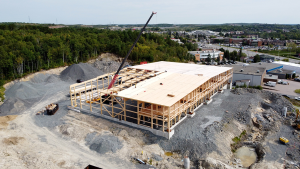If there is one building process on the tips of the construction industry’s tongue these days, it’s mass timber construction (MTC). Enthusiasm for manufactured wood components as an alternative to steel and concrete is growing worldwide due to wood’s ability to absorb and retain carbon emissions. Studies also highlight wood’s structural and aesthetic values, while codes are coming to grips with critical issues pertaining to MTC in larger, taller buildings.
However, that doesn’t mean a free environmental pass for wood.
William Holden, a construction material executive with over 30 years’ experience, wrote in the December 2019 edition of Concrete Products magazine, “The simple fact is that wood is wholly unsuitable for mass construction. It lacks the strength, durability, and safety of concrete. And there’s obviously catastrophic potential for more air pollution from more logging and timber manufacture, the destruction of existing forests.”
While MTC proponents might question some of Holden’s statements concerning strength, durability and safety, the end-to-end environmental impact of mass timber has not been investigated as extensively as those associated with steel and concrete.
There are carbon and GHGs resulting from the harvesting of mature trees, transporting logs, manufacturing glulam or cross laminated products (CLT), and transporting them to distribution centres across continents or oceans and on to building sites. These can vary greatly. With recent forecasts from the World Bank suggesting that global timber demand will quadruple by 2050, the subject becomes all the more pertinent.
In a 2018 study titled, “From Sawmill to Final Products”, authors Adhikari and Ozarska write that, “Steel and concrete consume 12 and 20 per cent more energy than wood products respectively. Similarly, steel emits 15 per cent more GHG than wood and concrete emits 29 per cent GHG more than wood.”
It is not all clear sailing, however. “Major sources of environmental impacts occur throughout the wood supply chain from sawmills to final products,” the study continues. “Timber products may create various kinds of environmental impacts at different stages of the timber product supply chain, from harvesting to their disposal.”
Specifically, there are energy source emissions related to sawmill operations plus gases associated with the milling production process. Other contributors throughout the supply chain involve the manufacture of the mass timber components — adhesives, coatings and waste products. Transportation by truck, rail or sea also contributes to emissions, since distances between original sources and end users add up. And depending on the use and placement of mass timber, chemicals may be needed to preserve wood components throughout their life.
Adhikari and Ozarska offer a number of suggestions that can mitigate these environmental impacts. However, the fact remains that these impacts exist and actions are required to reduce them.
The other issue is the sustainability of the world’s forests, if the World Bank’s prediction concerning the increased use of wood is accurate. Environmentalists repeatedly point out that wood is nature’s carbon bank and therefore the world needs more trees than ever.
Using wood in place of steel and concrete could reportedly save up to 31 per cent of global carbon emissions and between 12 to 19 per cent of global fossil fuel consumption. However, a 2013 study published in the Journal of Materials Science Research offers a warning. “The overall demand for wood and wood based composites is rising, while the available wood supply will decrease due to the global biomass demands for the green energy generation.”
Other studies disagree. Trees are currently growing faster than they are being harvested, according to a Food and Agriculture Organization Corporate Statistical Database (2012) estimate. Assuming properly managed forestry techniques, a 2014 study titled, “Carbon, Fossil Fuel, and Biodiversity Mitigation With Wood and Forests”, states that, “It is highly likely that the world could harvest much more wood and still harvest sustainably — that is, harvest no more than is growing.”
What is apparent is this: While the increased use of mass timber offers compelling solutions to the world’s GHG and carbon issues, a fuller and more current understanding of the overall environmental impact is required.
John Bleasby is a Coldwater, Ont. based freelance writer. Send comments and Inside Innovation column ideas to editor@dailycommercialnews.com.








Recent Comments
comments for this post are closed